fuel pressure TOYOTA FJ CRUISER 2011 1.G Owners Manual
[x] Cancel search | Manufacturer: TOYOTA, Model Year: 2011, Model line: FJ CRUISER, Model: TOYOTA FJ CRUISER 2011 1.GPages: 528, PDF Size: 10.93 MB
Page 7 of 528
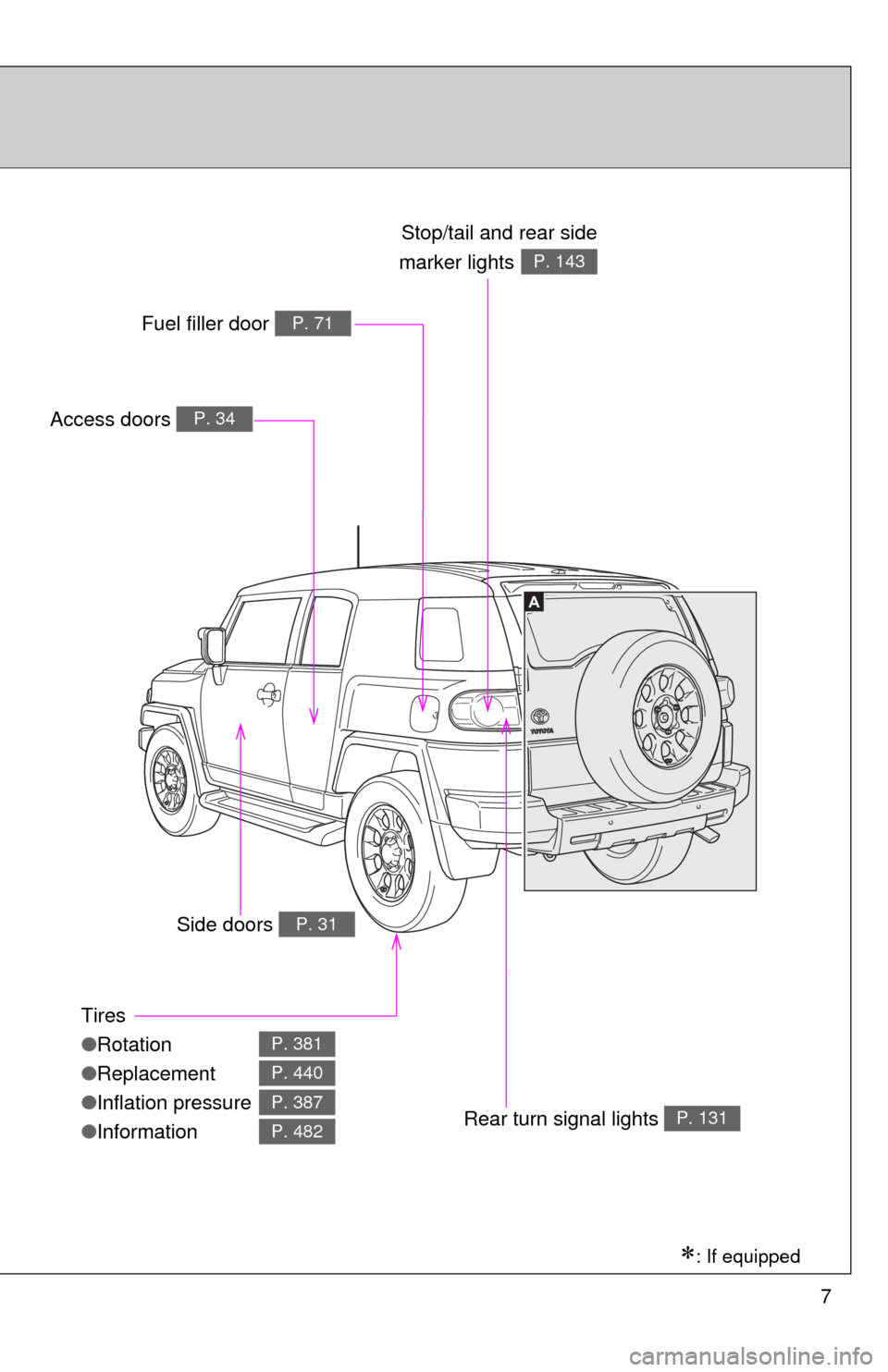
7
A
Tires
●Rotation
● Replacement
● Inflation pressure
● Information
P. 381
P. 440
P. 387
P. 482
Access doors P. 34
Fuel filler door P. 71
Rear turn signal lights P. 131
Stop/tail and rear side
marker lights
P. 143
Side doors P. 31
: If equipped
Page 350 of 528
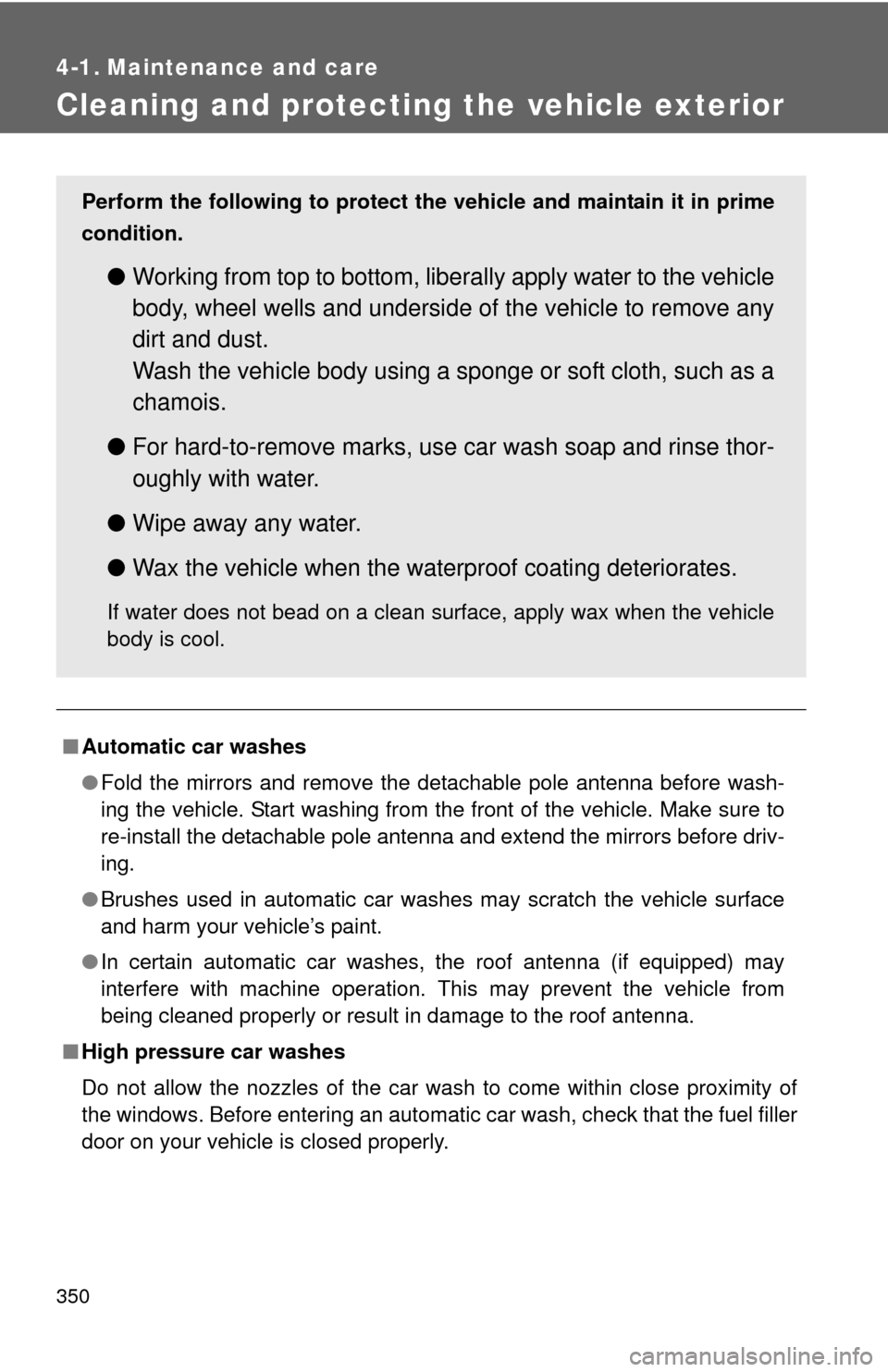
350
4-1. Maintenance and care
Cleaning and protecting the vehicle exterior
■Automatic car washes
●Fold the mirrors and remove the detachable pole antenna before wash-
ing the vehicle. Start washing from the front of the vehicle. Make sure to
re-install the detachable pole antenna and extend the mirrors before driv-
ing.
● Brushes used in automatic car washes may scratch the vehicle surface
and harm your vehicle’s paint.
● In certain automatic car washes, the roof antenna (if equipped) may
interfere with machine operation. This may prevent the vehicle from
being cleaned properly or result in damage to the roof antenna.
■ High pressure car washes
Do not allow the nozzles of the car wash to come within close proximity \
of
the windows. Before entering an automatic car wash, check that the fuel filler
door on your vehicle is closed properly.
Perform the following to protect the vehicle and maintain it in prime
condition.
● Working from top to bottom, liber ally apply water to the vehicle
body, wheel wells and underside of the vehicle to remove any
dirt and dust.
Wash the vehicle body using a sponge or soft cloth, such as a
chamois.
● For hard-to-remove marks, use car wash soap and rinse thor-
oughly with water.
● Wipe away any water.
● Wax the vehicle when the waterproof coating deteriorates.
If water does not bead on a clean surface, apply wax when the vehicle
body is cool.
Page 389 of 528

389
4-3. Do-it-yourself maintenance
4
Maintenance and care
■Tire inflation pressure check interval
You should check tire pressure every two weeks, or at least once a
month.
Do not forget to check the spare.
■Effects of incorrect tire inflation pressure
Driving with incorrect ti
re inflation pressure ma y result in the following:
●Reduced fuel efficiency
●Reduced driving comfort and tire life
●Reduced safety
●Damage to the drive train
If a tire needs frequent re filling, have it checked by your Toyota dealer.
■Instructions for checking tire inflation pressure
When checking tire inflation pressure, observe the following:
●Check only when the tires are cold.
If your vehicle has been parked for at least 3 hours and has not been
driven for more than 1 mile or 1.5 km, you will get an accurate cold
tire inflation pressure reading.
●Always use a tire pressure gauge.
The appearance of the tire can be mi sleading. In addition, tire infla-
tion pressures that are even just a few pounds off can degrade ride
and handling.
●Do not bleed or reduce tire inflation pressure after driving. It is normal
for the tire inflation pressure to be higher after driving.
●Never exceed the vehicle capacity weight.
Passengers and luggage weight should be placed so that the vehicle
is balanced.
Page 433 of 528
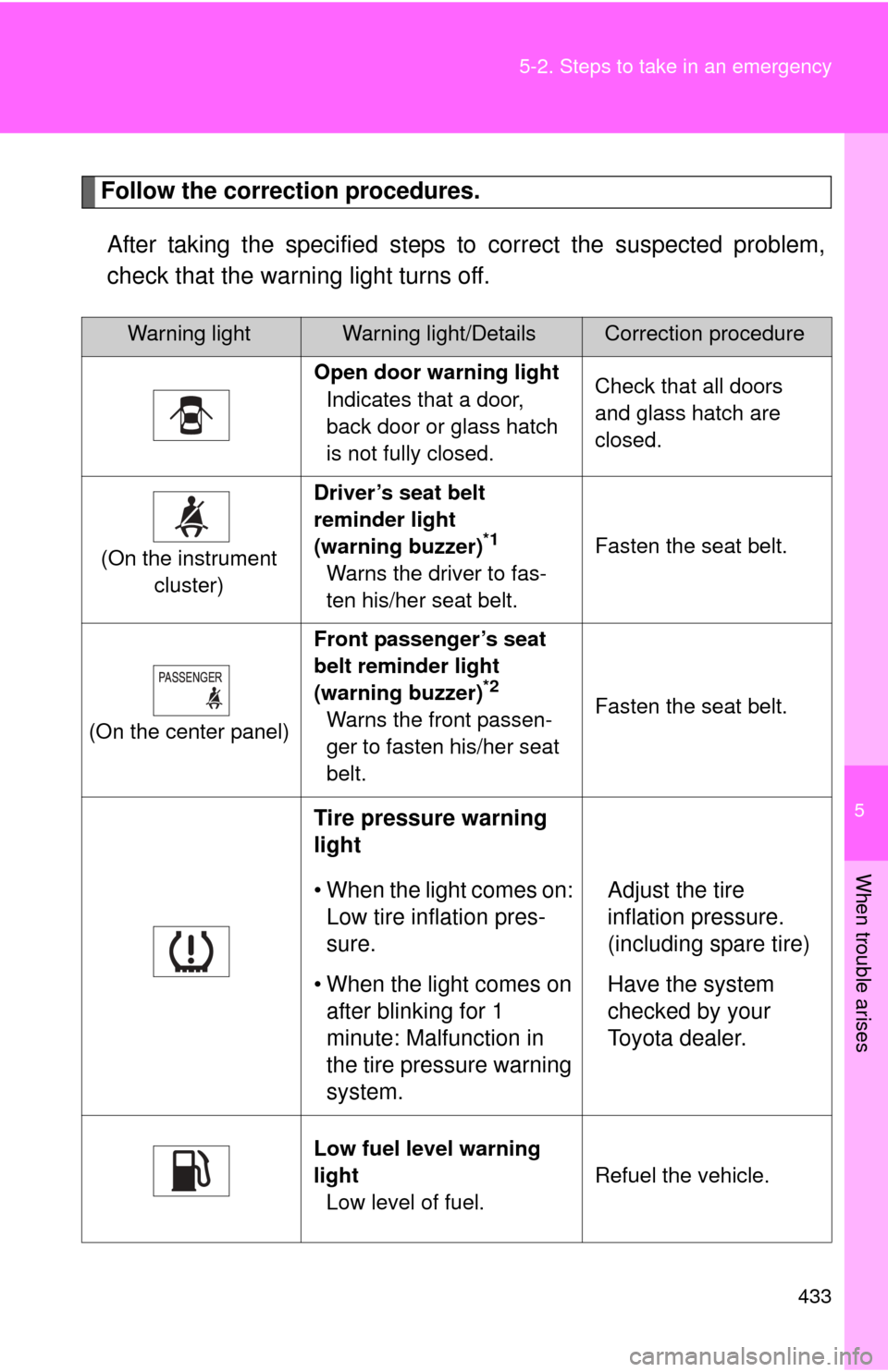
5
When trouble arises
433
5-2. Steps to take in an emergency
Follow the correction procedures.
After taking the specified steps to correct the suspected problem,
check that the warning light turns off.
Warning lightWarning light/DetailsCorrection procedure
Open door warning light Indicates that a door,
back door or glass hatch
is not fully closed. Check that all doors
and glass hatch are
closed.
(On the instrument cluster) Driver’s seat belt
reminder light
(warning buzzer)
*1
Warns the driver to fas-
ten his/her seat belt.
Fasten the seat belt.
(On the center panel) Front passenger’s seat
belt reminder light
(warning buzzer)
*2
Warns the front passen-
ger to fasten his/her seat
belt.
Fasten the seat belt.
Tire pressure warning
light
• When the light comes on:
Low tire inflation pres-
sure. Adjust the tire
inflation pressure.
(including spare tire)
• When the light comes on after blinking for 1
minute: Malfunction in
the tire pressure warning
system. Have the system
checked by your
Toyota dealer.
Low fuel level warning
light
Low level of fuel. Refuel the vehicle.
Page 435 of 528
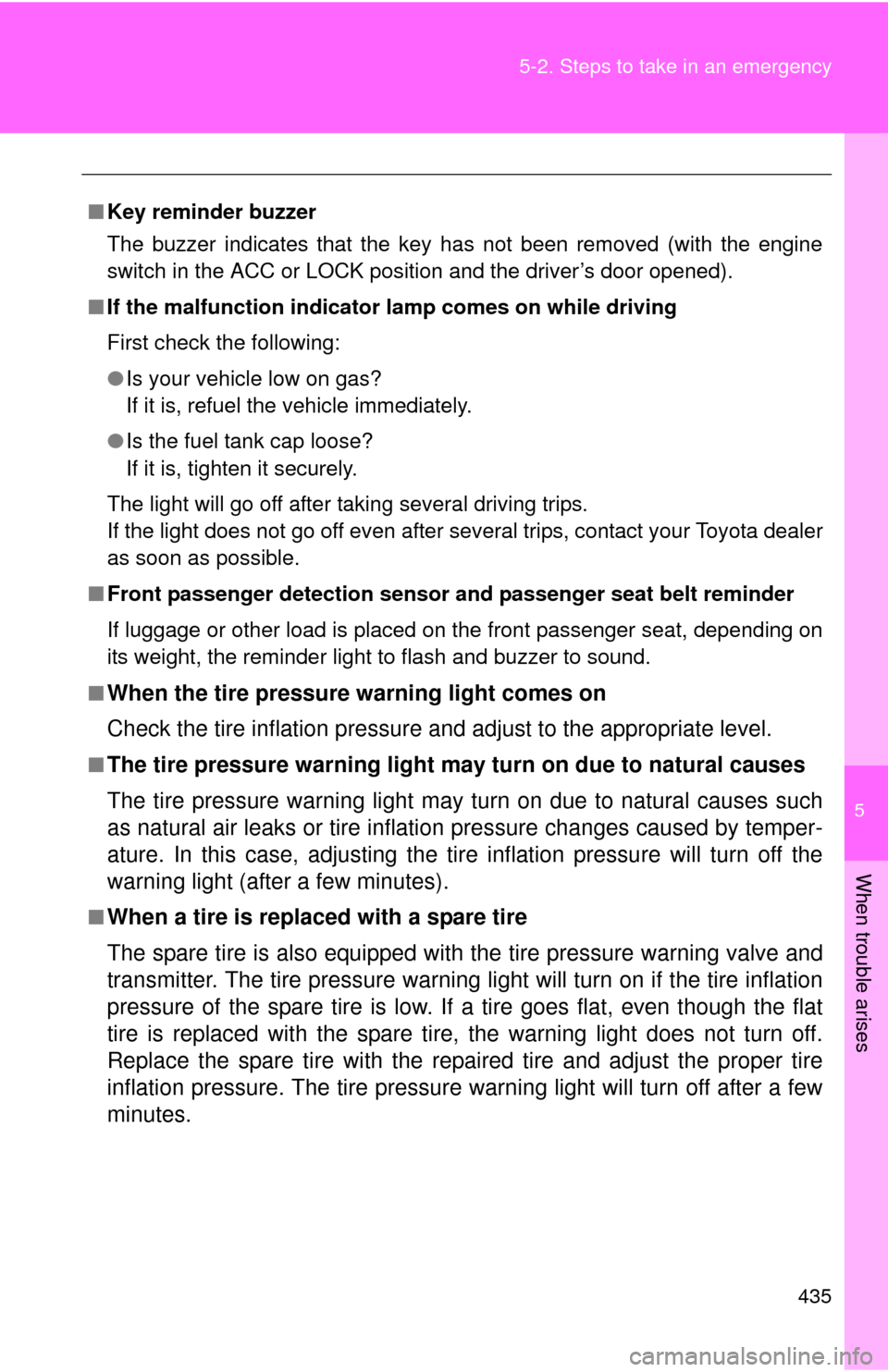
5
When trouble arises
435
5-2. Steps to take in an emergency
■
Key reminder buzzer
The buzzer indicates that the key has not been removed (with the engine
switch in the ACC or LOCK position and the driver’s door opened).
■ If the malfunction indicator lamp comes on while driving
First check the following:
● Is your vehicle low on gas?
If it is, refuel the vehicle immediately.
● Is the fuel tank cap loose?
If it is, tighten it securely.
The light will go off after taking several driving trips.
If the light does not go off even after several trips, contact your Toyota dealer
as soon as possible.
■ Front passenger detection sensor and passenger seat belt reminder
If luggage or other load is placed on the front passenger seat, depending on
its weight, the reminder light to flash and buzzer to sound.
■
When the tire pressure warning light comes on
Check the tire inflation pressure and adjust to the appropriate level.
■The tire pressure warning light may turn on due to natural causes
The tire pressure warning light may turn on due to natural causes such
as natural air leaks or tire inflation pressure changes caused by temper-
ature. In this case, adjusting the ti re inflation pressure will turn off the
warning light (after a few minutes).
■When a tire is replaced with a spare tire
The spare tire is also equipped with the tire pressure warning valve and
transmitter. The tire pressure warning li ght will turn on if the tire inflation
pressure of the spare tire is low. If a tire goes flat, even though the flat
tire is replaced with the spare tire, the warning light does not turn off.
Replace the spare tire with the repair ed tire and adjust the proper tire
inflation pressure. The ti re pressure warning light will turn off after a few
minutes.
Page 438 of 528
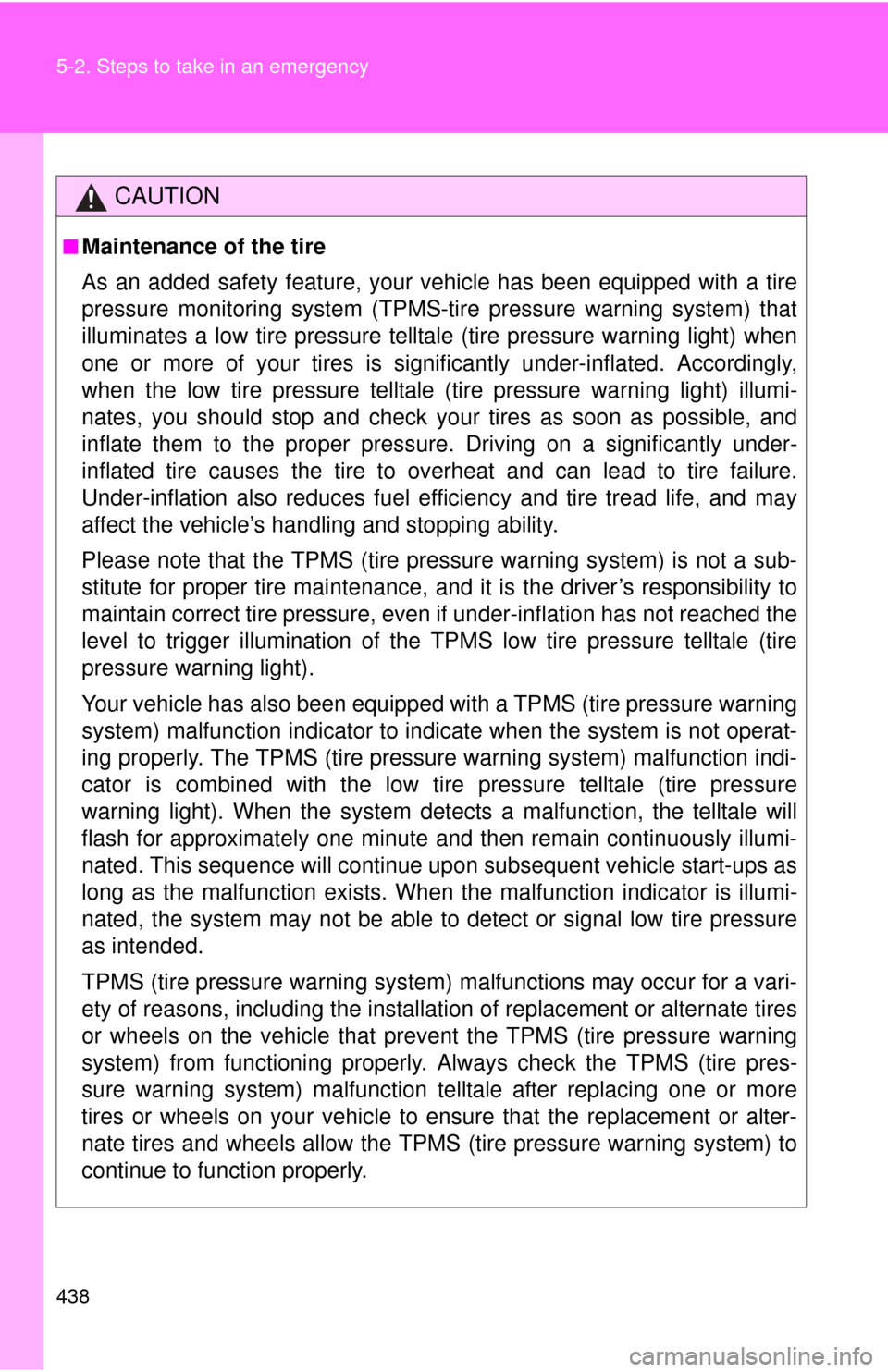
438 5-2. Steps to take in an emergency
CAUTION
■Maintenance of the tire
As an added safety feature, your vehicle has been equipped with a tire
pressure monitoring system (TPMS-ti re pressure warning system) that
illuminates a low tire pressure telltal e (tire pressure warning light) when
one or more of your tires is significantly under-inflated. Accordingly,
when the low tire pressu re telltale (tire pressure warning light) illumi-
nates, you should stop and check your tires as soon as possible, and
inflate them to the proper pressure. Driving on a significantly under-
inflated tire causes the tire to overheat and can lead to tire failure.
Under-inflation also reduces fuel effi ciency and tire tread life, and may
affect the vehicle’s handling and stopping ability.
Please note that the TPMS (tire pressure warning system) is not a sub-
stitute for proper tire main tenance, and it is the driver’s responsibility to
maintain correct tire pressure, even if under-inflation has not reached the
level to trigger illu mination of the TPMS low tire pressure telltale (tire
pressure warning light).
Your vehicle has also been equipped with a TPMS (tire pressure warning
system) malfunction indicator to indi cate when the system is not operat-
ing properly. The TPMS (tire pressure warning system) malfunction indi-
cator is combined with the low tire pressure telltale (tire pressure
warning light). When the system det ects a malfunction, the telltale will
flash for approximately one minute an d then remain continuously illumi-
nated. This sequence will continue upon subsequent vehicle start-ups as
long as the malfunction exists. When the malfunction indi cator is illumi-
nated, the system may not be able to detect or signal low tire pressure
as intended.
TPMS (tire pressure warning system) malfunctions may occur for a vari-
ety of reasons, including the installati on of replacement or alternate tires
or wheels on the vehicle that prevent the TPMS (tire pressure warning
system) from functioning properly. Always check the TPMS (tire pres-
sure warning system) malfunction te lltale after replacing one or more
tires or wheels on your vehicle to ensure that the replacement or alter-
nate tires and wheels allow the TPMS (tire pressure warning system) to
continue to function properly.
Page 487 of 528

487
6-1. Specifications
6
Vehicle specifications
Warning: The temperature grades for this tire are established for a
tire that is properly inflated and not overloaded.
Excessive speed, underinflation,
or excessive loading, either
separately or in combination, can cause heat buildup and possible
tire failure.
Glossary of tire terminology
Tire related termMeaning
Cold tire inflation
pressure
Tire pressure when the vehicle has been
parked for three hours or more, or has not
been driven more than 1 mile or 1.5 km under
that condition
Maximum inflation
pressureThe maximum cold inflated pressure to which a
tire may be inflated, s hown on the sidewall of
the tire
Recommended
inflation pressureCold tire inflation pressure recommended by a
manufacturer
Accessory weight
The combined weight (in excess of those
standard items which may be replaced) of
transmission, power steering, power brakes,
power windows, power seats, radio and heater,
to the extent that these items are available as
factory-installed equipment (whether installed
or not)
Curb weight
The weight of a motor vehicle with standard
equipment, including the maximum capacity of
fuel, oil and coolant, and if so equipped, air
conditioning and additional weight optional
engine
Maximum loaded
vehicle weight
The sum of:
(a) Curb weight
(b) Accessory weight
(c) Vehicle capacity weight
(d) Production options weight
Page 522 of 528

522 Alphabetical index
Tools ......................................... 440
Total load capacity................... 189
TowingDinghy towing........................ 203
Emergency towing................. 421
Trailer towing......................... 193
Traction control system .......... 175
TRAC (TRC) .............................. 175
Trip meter ................................. 135
Turn signal lights Lever ..................................... 131
Replacing light bulbs ............. 410
Switch.................................... 131
Wattage ................................. 478
Vanity mirrors........................... 326
Vehicle identification number ................................... 469
Vehicle stability control........... 175
Voltmeter .................................. 135
VSC............................................ 175
Warning buzzers Key reminder ......................... 435
Seat belt reminder ................. 433
Warning lights ABS ....................................... 431
Airbag system ....................... 431
Anti-lock brake system .......... 431
Automatic transmission fluid
temperature ........................ 431
Brake system ........................ 430
Charging system .... ............... 431
Driver’s seat belt ................... 433
Electronic engine control system ................................ 431
Engine oil replacement.......... 433 Front passenger occupant
classification system ........... 431
Front passenger’s seat belt... 433
Low brake fluid ...................... 430
Low engine oil pressure ........ 431
Low fuel level ........................ 433
Low tire inflation pressure ..... 433
Low washer fluid ................... 434
Malfunction indicator lamp .... 431
Open door ............................. 433
Seat belt ................................ 433
Seat belt pretensioner system ................................ 431
SRS....................................... 431
SRS airbag system ............... 431
Tire pressure ......................... 433
Tire pressure warning
system ................................ 433
Unengaged “Park”................. 431
Washer
Checking ............................... 379
Preparing and checking before winter ....................... 190
Switch ........................... 145, 147
Washing and waxing ............... 350
Weight Cargo capacity ...................... 185
Load limits ............................. 189
Weight ................................... 468
Wheels ...................................... 391
Window glasses .................. 41, 69
Window lock switch................... 69
Windows Power windows ....................... 69
Rear window defogger .......... 213
Washer.......................... 145, 147
Windshield wipers ........... 145, 147
V
W
Page 526 of 528
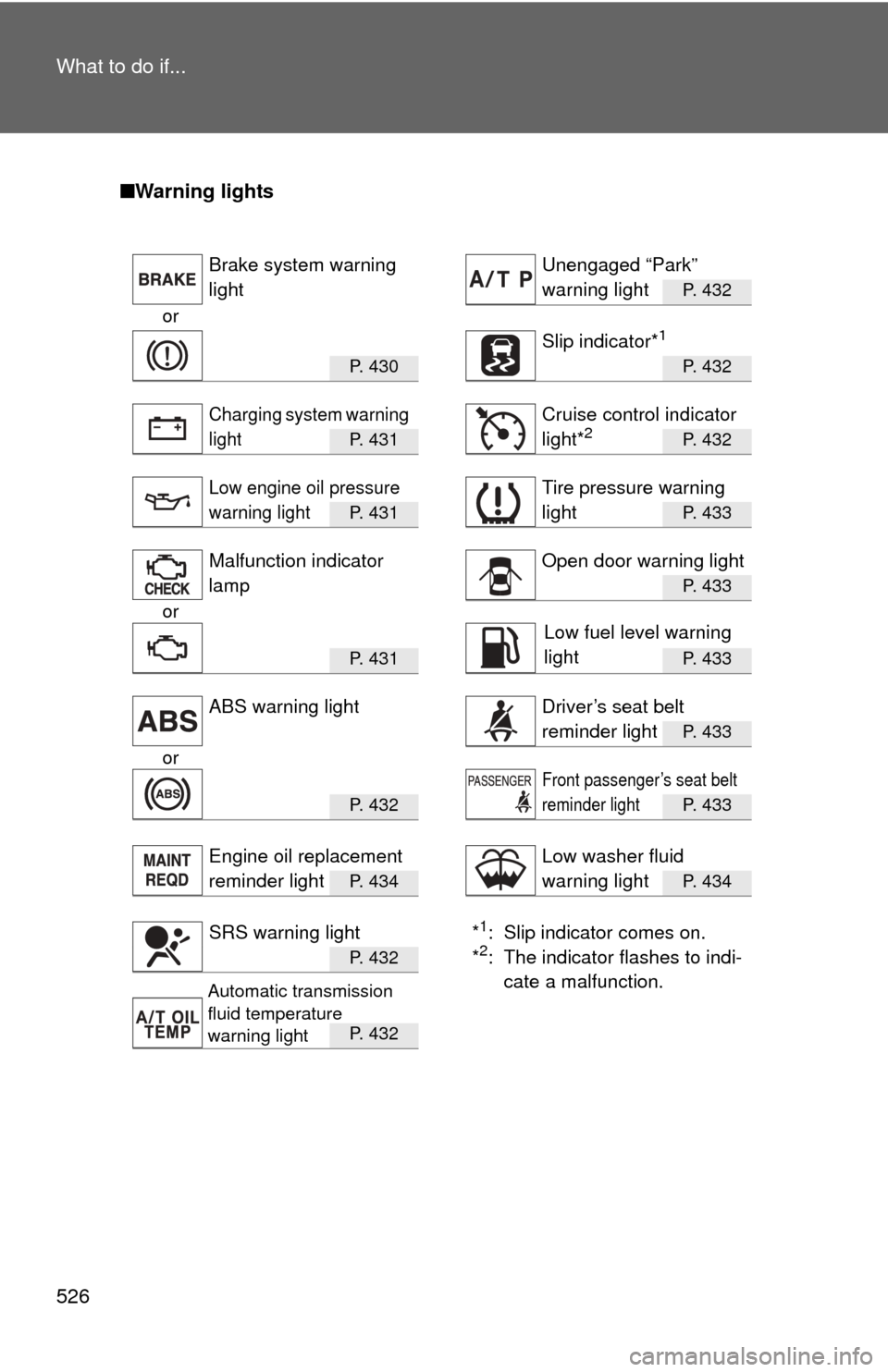
526 What to do if...
■Warning lights
P. 432
or
P. 430 P. 432
P. 431 P. 432
P. 431 P. 433
P. 433
or
P. 4 3 1P. 433
P. 433
or
P. 4 3 2P. 433
P. 4 3 4P. 434
*1: Slip indicator comes on.
*2: The indicator flashes to indi- cate a malfunction.P. 4 3 2
P. 4 3 2
Brake system warning
lightUnengaged “Park”
warning light
Slip indicator*1
Charging system warning
lightCruise control indicator
light*2
Low engine oil pressure
warning lightTire pressure warning
light
Malfunction indicator
lampOpen door warning light
Low fuel level warning
light
ABS warning lightDriver’s seat belt
reminder light
Front passenger’s seat belt
reminder light
Engine oil replacement
reminder lightLow washer fluid
warning light
SRS warning light
Automatic transmission
fluid temperature
warning light
Page 528 of 528
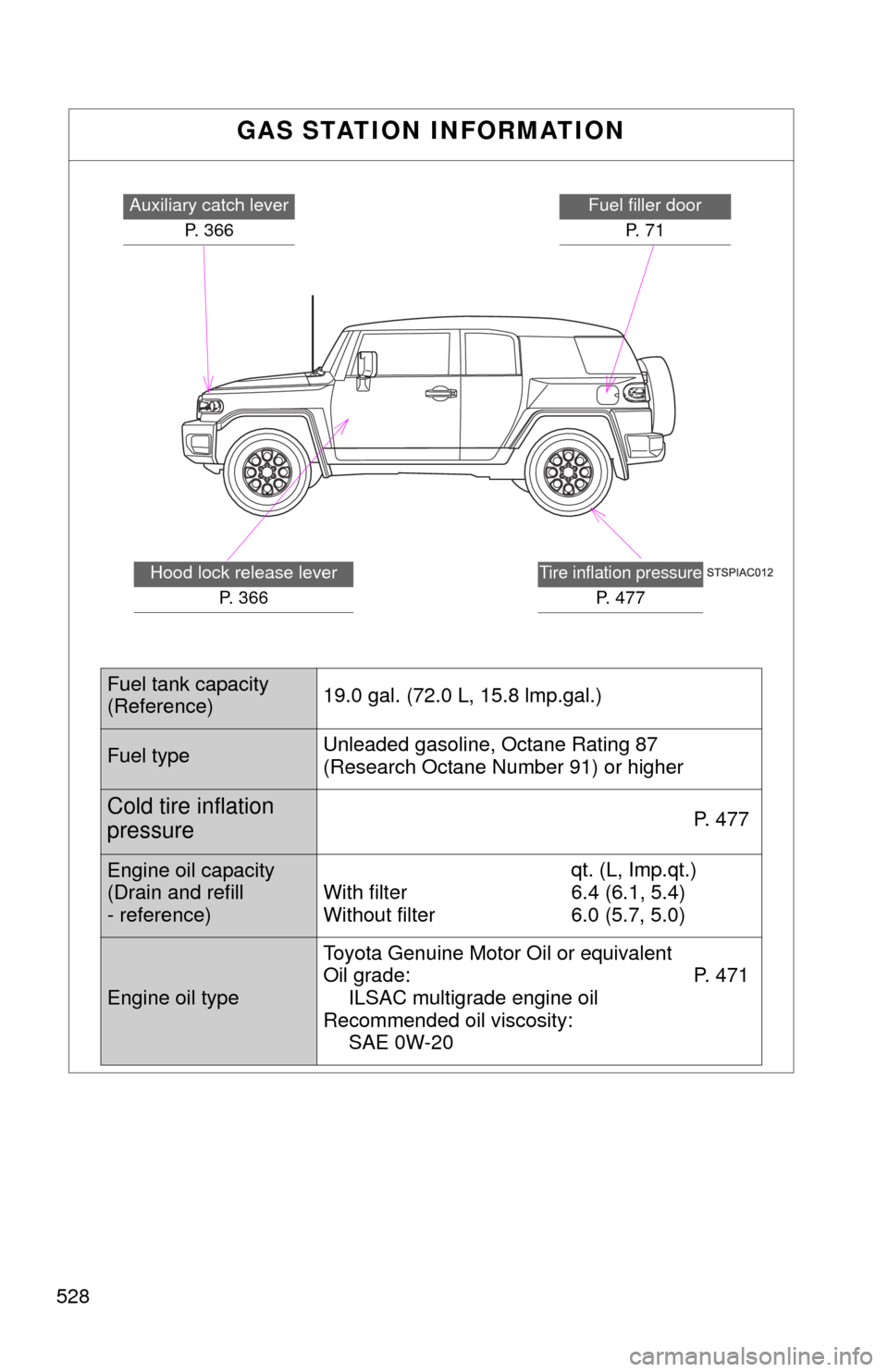
528
GAS STATION INFORMATION
Auxiliary catch leverP. 366Fuel filler doorP. 7 1
Tire inflation pressure
P. 4 7 7
Hood lock release lever P. 366
Fuel tank capacity
(Reference) 19.0 gal. (72.0 L, 15.8 lmp.gal.)
Fuel typeUnleaded gasoline, Octane Rating 87
(Research Octane Number 91) or higher
Cold tire inflation
pressureP. 4 7 7
Engine oil capacity
(Drain and refill
- reference) qt. (L, Imp.qt.)
With filter 6.4 (6.1, 5.4)
Without filter 6.0 (5.7, 5.0)
Engine oil type Toyota Genuine Motor Oil or equivalent
Oil grade: P. 471
ILSAC multigrade engine oil
Recommended oil viscosity: SAE 0W-20